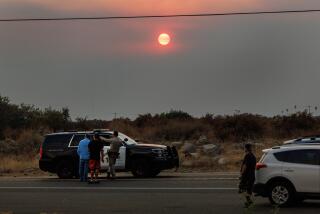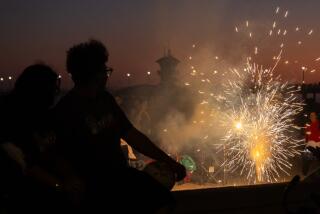Must Reads: The Fourth of July brings some of the year’s worst air pollution. You can thank fireworks
Americans’ fervor for Fourth of July fireworks has some unfortunate side effects.
There’s a jump in fires, gruesome injuries and runaway pets spooked by the noise.
But there’s also a more widespread hazard from the yearly outburst of pyrotechnics: It spikes air pollution so sharply it becomes dangerous for everyone to breathe.
Independence Day and July 5 consistently have some of the worst air quality of the year. With so many fireworks going off at once, levels of fine-particle pollution — a stew of tiny, lung-damaging specks of toxic soot, smoke and ash known as PM2.5 — surge several times higher than federal health standards across Southern California, air monitoring data show.
Pollution levels jump sharply around 8 or 9 p.m. the evening of the Fourth of July, around when it gets dark, reaching their peak late in the night. The unhealthy pall hangs in the still, nighttime air and lingers through the following morning — a kind of hazy hangover from the night’s revelry.
“It can be one of our highest PM2.5 periods of the year,” said Kevin Durkee, a quality assurance manager with the South Coast Air Quality Management District. “All that smoke from across the basin is ending up someplace, often in the foothills or the Inland Empire by the day after the Fourth of July.”
In downtown Los Angeles last year, fine particle pollution jumped above 300 micrograms per cubic meter — more than eight times the daily average health standard of 35 — and remained elevated through the following morning. A similar bad air spell occurs each Fourth of July across Southern California, from Orange County and Long Beach to Santa Clarita and the San Gabriel Valley.
The phenomenon isn’t unique to L.A. A 2015 nationwide study by U.S. government scientists found that on average, concentrations of fine-particle pollution for the 24-hour period beginning at 8 p.m. on the Fourth of July are 42% higher than on other days.
Air quality also takes a dive across Southern California on other holidays as a result of wood-burning fireplaces and fireworks on Christmas and New Year’s.
Some authorities say pollution is yet another reason people should opt for professional pyrotechnics displays and not add to the problem by setting off their own personal fireworks, which are illegal in many communities, including the City of Los Angeles.
“We’re not telling people to not have fireworks or anything, but we do want to let people know that there’s usually a heightened health impact starting in the evening of the Fourth and into the morning of the 5th,” Durkee said.
The South Coast air district issued a “particulate advisory” Tuesday that Los Angeles, Orange, Riverside and San Bernardino counties can reach unhealthy levels during and after Independence Day fireworks displays, saying people with asthma, heart or lung disease, older adults, and children should limit their outdoor activities.
Elsewhere, regulators are urging people to curb their fireworks use. The San Joaquin Valley Air Pollution Control District sent out a warning asking residents to consider the threat to public health before setting them off.
“Each year, people suffer serious health consequences from direct exposure in the neighborhoods where they live and breathe . . . from firework activities that are entirely preventable,” Samir Sheikh, the district’s deputy air pollution control officer said in a news release.
In Southern California, the eruption of smoke from fireworks adds to what is already some of the nation’s worst-polluted air.
All those extra fine particles in the air concern experts and regulators because they are an especially harmful type of pollution. PM2.5 can penetrate deep in the lungs and trigger heart attacks, strokes and other adverse health effects. Most vulnerable are children, the elderly and those with existing heart and lung diseases.
Fourth of July pollution may pose even greater risks compared with typical smog because it contains higher concentrations of toxic metals like barium and copper that are used in fireworks to generate bright colors, said Jun Wu, a professor of public health at UC Irvine who has studied the effects of air pollution.
“Those vulnerable populations may have a higher burden than usual,” Wu said. “It’s not just during the half an hour of fireworks; these particles float in the air for a few days or even a week.”
To protect yourself, Wu and others suggest watching fireworks shows away from any plumes of smoke and keeping children’s windows closed while they sleep on the evening of the Fourth of July. You can check air quality in your area using real-time pollution maps.
The bout of poor air quality this Fourth of July will follow a streak of bad air days in the middle of the summer smog season, in which pollution has violated health standards for the last two weeks straight across Los Angeles, Orange, Riverside and San Bernardino counties. Only four days since June 1 have been within federal limits for ozone, the lung-damaging gas in smog that triggers asthma and other respiratory illness.
And there’s little relief in sight. Once the fireworks emissions wane, regulators are warning that record high temperatures and strong inversion layers forecast for this weekend threaten to produce unusually poor air quality for several more days. Those hot, stagnant conditions are expected to boost levels of ozone, an unstable gas that forms when emissions from across the region react in the heat and sunlight.
South Coast air district forecasters say residents should prepare for a days-long episode of high and widespread ozone pollution that extends outside the typical inland hotspots. How quickly it ebbs depends almost entirely on the weather.
More to Read
Sign up for Essential California
The most important California stories and recommendations in your inbox every morning.
You may occasionally receive promotional content from the Los Angeles Times.












